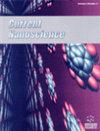用绿色合成的大马士革玫瑰花碳量子点荧光测定 Fe3+ 离子
IF 1.5
4区 材料科学
Q4 BIOTECHNOLOGY & APPLIED MICROBIOLOGY
引用次数: 0
摘要
背景::碳量子点的合成、表征和应用最近引起了广泛关注。在天然材料中发现了最有效的碳前驱体,可用于制造具有奇妙化学和物理特性的碳点。研究目的在本研究中,我们介绍了一种新方法,使用一种具有吸收和发射能力的碳点系统,从而开发出一种荧光测定法来检测 Fe3+ 金属离子。方法:利用大马士革玫瑰花瓣通过水热法合成了大马士革玫瑰碳量子点(DRCQDs),并进行了紫外可见光、FE-SEM、EDS 和元素图谱等各种表征。CQDs 的荧光强度随介质中存在的特定金属离子而变化,蓝色荧光被选择性淬灭。结果为了在 330 nm 的激发波长下检测 Fe3+ 离子,使用了 CQDs,通过改变激发波长,CQDs 在 280 到 400 nm 之间产生了广泛的发射光谱。与其他重金属相比,Fe3+ 离子对 CQDs 具有更强的荧光淬灭效应。根据光谱测量,生成的碳点的检测限为 1.11 μM,可在 0-80 μM 的浓度范围内测定 Fe3+ 离子。结论这种新型荧光碳点技术为快速有效地识别 Fe3+ 离子提供了一种可行的方法,尤其是在实际样品中。本文章由计算机程序翻译,如有差异,请以英文原文为准。
Fluorometric Determination of Fe3+ Ions Using Green Synthesized Carbon Quantum Dots from Damask Rose flowers
Background:: Carbon quantum dot synthesis, characterization, and applications have drawn a lot of attention lately. The most effective carbon precursors for creating carbon dots with intriguing chemical and physical characteristics are found in natural materials. Objectives:: In this study, we introduced a new approach using a carbon dot system that possesses both absorption and emission capabilities, allowing for the development of a fluorometric assay to detect Fe3+ metal ions. Method:: Hydrothermally, the Damask rose Carbon Quantum Dots (DRCQDs) were synthesized using Damask rose flower petals and various characterisations were performed, such as UV-Vis, FE-SEM, EDS, and Elemental mapping. The fluorescence intensity of CQDs varies depending on the particular metal ion present in the medium, and the blue fluorescence was selectively quenched. Results:: For the purpose of detecting Fe3+ ions at an excitation of 330 nm, CQDs were employed, which produced an extensive emission spectrum between 280 and 400 nm by varying the excitation wavelengths. More than other heavy metals, Fe3+ ions were observed to have a stronger fluorescence quenching effect for the CQDs. According to spectroscopic measurements, the generated carbon dots have a detection limit of 1.11 μM and could determine Fe3+ ions in the range of concentrations from 0–80 μM. Conclusion:: This new fluorescent carbon dot technology offers a promising method for the quick and effective identification of Fe3+ ions, particularly in real-world samples.
求助全文
通过发布文献求助,成功后即可免费获取论文全文。
去求助
来源期刊

Current Nanoscience
工程技术-材料科学:综合
CiteScore
3.50
自引率
6.70%
发文量
83
审稿时长
4.4 months
期刊介绍:
Current Nanoscience publishes (a) Authoritative/Mini Reviews, and (b) Original Research and Highlights written by experts covering the most recent advances in nanoscience and nanotechnology. All aspects of the field are represented including nano-structures, nano-bubbles, nano-droplets and nanofluids. Applications of nanoscience in physics, material science, chemistry, synthesis, environmental science, electronics, biomedical nanotechnology, biomedical engineering, biotechnology, medicine and pharmaceuticals are also covered. The journal is essential to all researches involved in nanoscience and its applied and fundamental areas of science, chemistry, physics, material science, engineering and medicine.
Current Nanoscience also welcomes submissions on the following topics of Nanoscience and Nanotechnology:
Nanoelectronics and photonics
Advanced Nanomaterials
Nanofabrication and measurement
Nanobiotechnology and nanomedicine
Nanotechnology for energy
Sensors and actuator
Computational nanoscience and technology.
 求助内容:
求助内容: 应助结果提醒方式:
应助结果提醒方式:


